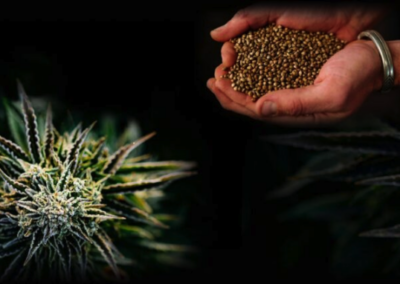Autoflower strains are those cannabis strains that start to flower automatically when the physiology of the plants are ready, regardless of the amount of sun/grow light hours they get. Since autoflower strains are not dependent on the duration of light to start flowering as are more common photoperiod strains, they offer many benefits to commercial autoflower farmers and autoflower hobbyists alike.
Perhaps the main feature of running autoflower strains is the incredibly fast seed-to-harvest cycle, and its predictability. For commercial autoflower farmers it can mean beating the competition to market with high quality autoflower buds and allied products such as autoflower vape cartridges and concentrates. This results by virtue of the fact an outdoor autoflower planting established in the spring can produce a full rich autoflower harvest in July versus late summer and early fall harvest cycles photoperiod farmers must follow.
For the hobbyist grower, both indoors and out, running autoflowers can simplify the grow process and reduce much of the anxiety and guesswork of how to care for their grows and when to harvest. You create autoflower starts using any of the proven autoflower germination techniques, plant, let grow in an autoflower propagation tent, and then do a final transplant to the autoflower’s final grow medium. At this point you light and feed autoflowers lightly as they move into flowering stages, typically 30 days after the autoflower starts are established.
You don’t even need to trim and pinch the stems of autoflower starts to create more stems and autoflower colas as you might a photoperiod strain. In fact, it is discouraged; an autoflower has its own internal growth mechanisms and fooling with them will typically have negative consequences.
What’s more, some amazing and very potent autoflower strains are being developed by renown autoflower geneticists around the world. And, while the autoflower practice has its legacy roots in Europe, today there are any number of highly qualified autoflower geneticists in the USA, which is experiencing a marked surge in the adoption of running autoflowers as both a harvest and business strategy.
All of which begs the question: where do autoflower seeds come from?
“Autoflower (genetic development) has been underground for a generation,” suggests Atlas Seed founder Ryan Power, a leading California producer of autoflower genetics for farmers & hobbyist growers. But now, with the wave of cannabis legalization sweeping across the USA, autoflower strains have become a ‘thing,’ with new and more potent autoflower strains being offered on an ongoing basis.
The origins of autoflower strains are shrouded in grower lore. However, at its core, autoflower strains are a result of cross-breeding a little known cannabis plant, Cannabis ruderalis, with its “sister” species, Cannabis sativa and Cannabis indica.
Cannabis ruderalis is thought to have originated in the northern climes of Russia and even some of the colder altitudes in Europe. Its name, which comes from the German word “ruderal” literally means “weed growing on the side of the road.”
As such, this sister autoflower species (or perhaps a sub-species of Cannabis sativa as some autoflower geneticists believe) had to evolve to survive. Not only did they need to adapt to colder temperatures, they needed to prosper and propagate during the long summer days. So Cannabis ruderalis developed its own set of flowering rules dictated not by light cycles but by the climate, available light, and nutrition.
Legend has it that during the 70s and 80s both Canadian growers, and some prominent breeders in the Netherlands started experimenting with crossing Ruderalis with Indica and Sativa strains with the goal of creating an autoflower strain, but only had marginal success. They simply could not produce a stable, potent and fully autoflower plant given Cannabis ruderalis is very low in THC content.
Then, around the beginning of the 21st century, geneticists on West Coast (USA) came upon a Mexican strain of Cannabis ruderalis, commonly known as “Mexican Rudy” which was seen to be very fast growing. This movement, led by a passionate breeder know as “The Joint Doctor,” succeeded in producing the first known autoflower strain called “The Lowryder.” A squat, fast to harvest autoflower, it was said to be a result of a cross-breeding of Mexican Rudy with a high THC content strain, Northern Lights, which also had a similar squat plant structure to ruderalis.
Like all cannabis strains, today’s autoflower strains have evolved to feature higher THC levels and have been fully stabilized to produce feminized autoflower genetics, which further reduces the possibility of male plants which can fast decimate a planting.
Now, while any number of autoflower strains are readily available, do your homework and see what autoflower strains are being grown by leading farms before you invest in autoflower genetics.
Bottom line: autoflower strains can mean all the difference to all levels of cannabis growers. But not all autoflower genetics are equal. Find some autoflower strains that have a proven track record, including THC potency, and you could well be on your way to autoflower nirvana.



